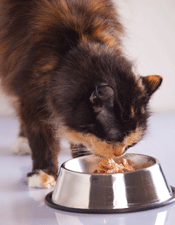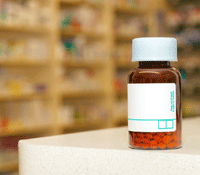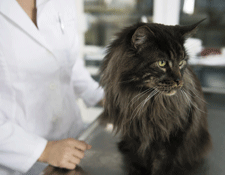Part 2
It has been estimated that around 20-50% of cats over 15 years of age will have some degree of chronic kidney disease. In ‘Chronic Kidney Disease in Cats Part 1’, we looked at what the disease is and how it can be diagnosed. In this article we focus on how chronic kidney disease in cats is treated.
How do you treat chronic kidney disease in cats?

Chronic kidney disease in cats is not reversible, however appropriate treatment can increase quality of life and slow disease progression
The goal in early stage kidney disease patients is to postpone or even fully prevent the development of uraemia. The goal in patients in the later stages of chronic kidney disease is to resolve the uraemia and bring the patient back to an earlier stage of disease.
If a specific cause for the chronic kidney disease is identified (eg, bacterial infection of the kidneys), treatment is prescribed (e.g. antibiotics) to arrest the progression of the disease. In most cases, however, treatment is aimed at reducing the symptoms of the disease. Many cats will need to initially be put on a drip (this is known as ‘intravenous fluid therapy’) to correct dehydration and eliminate the excessive build up of toxins in the blood (similar to dialysis in humans). Once stable, treatment goals are aimed at supporting kidney function and minimising the complications of chronic kidney disease, such as the development of uraemic episodes. Despite therapy, chronic kidney disease is considered irreversible and will eventually progress over time.
Optimal management of chronic kidney disease usually requires regular monitoring by your vet, including weight checks, blood and urine tests, and blood pressure assessment, to identify any treatable complications as they arise (eg, anaemia, low potassium, high phosphate levels, urinary tract infections, and high blood pressure).
Dietary management of chronic kidney disease in cats

Cats with chronic kidney disease should be fed wet (tinned/sachet) foods rather than dry foods whenever possible, to increase water intake
An ideal diet for a cat with renal failure is a diet low in phosphate and lower in protein compared to maintenance cat diets. Saying that, protein restriction must be performed with care as too much protein restriction can be extremely detrimental to the general health of the cat. This will result in the body breaking down its own muscle to satisfy requirements, resulting in significant weight loss/poor condition and can worsen kidney disease.
Low phosphate content
Restricting the phosphate content of the diet appears very beneficial in protecting the kidneys from further damage in cats with chronic kidney disease. While restricting protein in the diet helps maintain quality of life, restricting phosphate thus appears to prolong the life of cats with chronic kidney disease. If blood phosphate concentrations remain high despite being on a low phosphate diet, further treatment with drugs known as ‘phosphate binders’, which reduce the amount of phosphate absorbed from the intestine, may also be indicated.
Other dietary measures
Other aspects of the diet may also have an important role to play in helping manage cats with chronic kidney disease. These include:
- the addition of anti-oxidants to try to protect the kidneys against further damage
- essential fatty acids to help maintain blood flow through the kidneys and reduce inflammation
- added potassium to prevent hypokalaemia (low blood potassium)
Managing the change to a new diet
Cats will often develop a strong preference for particular diets. Lower protein diets can be less palatable and therefore changing a cat’s diet with the appropriate therapeutic diet can be challenging. These tips may help:
- Always make gradual changes over a period of 1-2 weeks, especially if your cat is considered ‘fussy’
- Only increase the amount of the new food once your cat is happy to eat the old mixture
- Warming the food to body temperature may help increase the palatability and stimulate appetite with the released aroma
In most cases, with sufficient care and time, cats can be very successfully transitioned to a new diet, and as this is such an important part of managing chronic kidney disease it is worth taking the time to do this properly.
If cats absolutely refuse to eat any of a new diet, it is important that they eat something, so keep offering their old diet in this situation and contact your vet for further advice.
Managing dehydration
Using a wet rather than a dry diet is important to increase water intake in cats with chronic kidney disease. However, they sometimes still do not consume enough water to compensate for what is being lost in the urine. In these cases, make sure a good supply of fresh water is always available, and cats should be encouraged to drink by offering several watering stations around the house (pint glasses filled with water are always useful!). Using flavoured waters (chicken, tuna spring water – not brine!) or water fountains can encourage drinking. Using intermittent intravenous fluid therapy at your vet clinic may be required every few months. Your vet can also teach you how to administer intermittent subcutaneous fluid therapy in the home environment.
Phosphate binders
If, despite using a low phosphate diet, blood phosphate levels remain high, using a phosphate binder added to the diet may be required. This is important, as controlling blood phosphate levels appears to have a good protective effect on the kidneys in cats with chronic kidney disease.
Potassium supplementation
Some cats with chronic kidney disease will also develop low blood potassium levels. This can cause muscle weakness, can contribute to poor appetite and itself can worsen chronic kidney disease. Where this is identified, potassium supplementation (usually in the form of tablets, gel or powder added to the diet) would be required.
Controlling blood pressure

There are a variety of medications that may be given to cats with chronic kidney disease to improve quality of life and slow down disease progression
Cats with chronic kidney disease are at risk of developing high blood pressure and this can have a number of damaging effects including acute blindness/blood accumulation in eyes, strain on heart muscle, and worsening of the kidney disease. Blood pressure should ideally be monitored in all cats with chronic kidney disease and can be treated with medication if diagnosed.
Treatment of anaemia
In advanced chronic kidney disease, anaemia can be quite common and is due to the lack of production of a hormone by the kidneys called erythropoeitin. This hormone stimulates the bone marrow to make red blood cells. Anaemia can also result from blood loss from the intestines due to the effects of toxins on the stomach lining. Severe anaemia may lead to lethargy and weakness and result in poor quality of life. Depending on the underlying cause, and severity, a variety of options may be available to alleviate the effects of anemia including iron supplementation, management of stomach ulceration, and the administration of erythropoietin to stimulate the bone marrow.
Treatment of nausea and vomiting
Nausea and vomiting are more common in advanced chronic kidney disease and can cause poor appetite and significantly affect a cat’s quality of life. Various drugs can be used to control these signs.
Use of ‘ACE inhibitors’ and ARBs (Angiotensin Receptor Blockers)
Blocking the activation of a hormone known as ‘angiotensin’ may be of benefit in chronic kidney disease in cats. This can be achieved by using so called ‘ACE-inhibitors’ (angiotensin converting enzyme inhibitors), or using angiotensin receptor blockers (ARBs).
Drugs such as ACE-inhibitors and angiotensin receptor blockers can benefit cats with chronic kidney disease by dilating blood vessels and supporting blood flow through the kidneys, lowering blood pressure, and also significantly reducing protein loss through the kidneys which can lead to the progression of disease, and so potentially improve survival in these patients.
What is the prognosis for cats with chronic kidney disease?

Your vet will be able to discuss the long term prognosis for your cat with you
Because chronic kidney disease is usually progressive over time, it will eventually lead to the need for euthanasia once it has reached ‘end stage’ with recurrent uraemic episodes. However, the rate of progression of kidney disease will vary considerably between individual cats. With appropriate support and treatment, quality of life can be improved and progression of the disease slowed down. Therefore the long term prognosis will greatly depend on the stage/severity of the disease and the underlying cause in each individual patient and your vet will be able to discuss this with you.
 The Veterinary Expert| Pet Health
The veterinary expert provides information about important conditions of dogs and cats such as arthrits, hip dysplasia, cruciate disease, diabetes, epilepsy and fits.
The Veterinary Expert| Pet Health
The veterinary expert provides information about important conditions of dogs and cats such as arthrits, hip dysplasia, cruciate disease, diabetes, epilepsy and fits.
 The Veterinary Expert| Pet Health
The veterinary expert provides information about important conditions of dogs and cats such as arthrits, hip dysplasia, cruciate disease, diabetes, epilepsy and fits.
The Veterinary Expert| Pet Health
The veterinary expert provides information about important conditions of dogs and cats such as arthrits, hip dysplasia, cruciate disease, diabetes, epilepsy and fits.